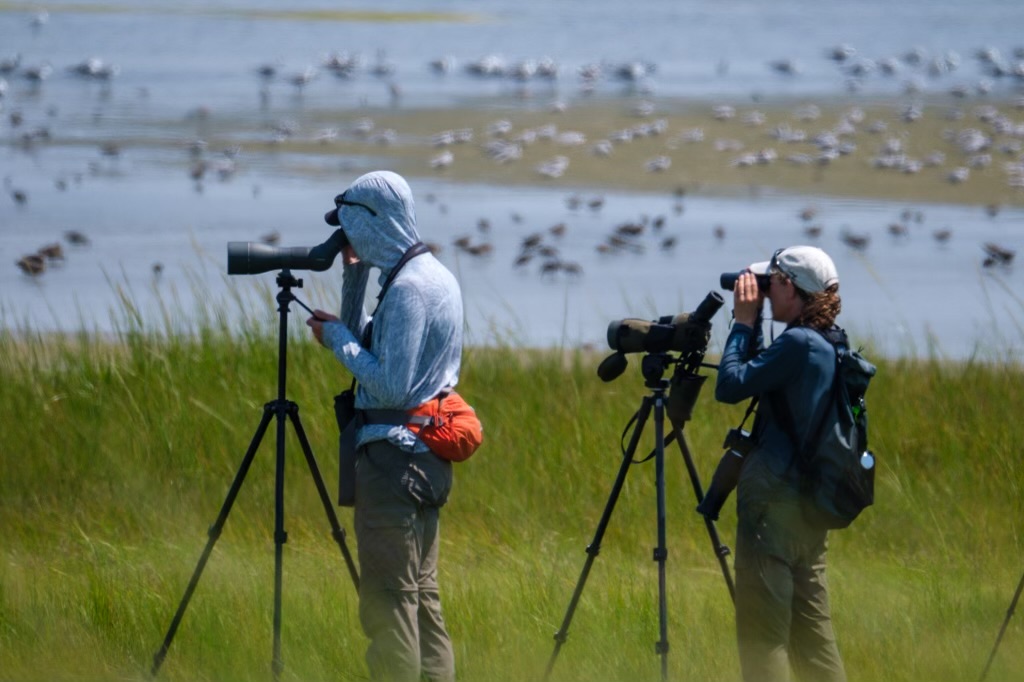By Stephen Brown, Vice President of Science, Manomet
Linked Paper: Accelerating declines of North America’s shorebirds signal the need for urgent conservation action by Paul A. Smith, Adam C. Smith, Brad Andres, Charles M. Francis, Brian Harrington, Christian Friis, R.I. Guy Morrison, Julie Paquet, Bradford Winn, and Stephen Brown, Ornithological Applications.
Nearly all shorebird species along the Atlantic Coast of the U.S. and Canada have experienced steep declines, with many losing more than 50 percent of their population over the last three decades. Since 1980, these declines have been monitored, recorded, and are now reflected in a recent study authored by researchers from Environment and Climate Change Canada, the U.S. Fish and Wildlife Service.
These declines show further evidence of the serious environmental changes impacting Earth’s biodiversity and natural landscapes, signaling a need for urgent conservation action to protect these long-distance migrants. While the trajectory of these declining numbers is alarming, it is important to emphasize that concerted conservation efforts can have a tangible positive impact. Targeted resources committed to recovery do work, so recovery is possible. If we can collectively focus and fortify conservation resources, it is possible to change direction.
To address current limitations of existing conservation efforts, researchers must first uncover the environmental changes impacting declining species at a local level — where shorebirds stop along their migratory journeys. Shorebirds undergo some of the longest migratory journeys of any animals on Earth, using habitats across a vast geography throughout their annual cycle to breed, nest, and refuel. Along the way they face increasing threats from habitat loss, predation, and disturbance. Knowing where shorebirds go during migration and what risks they face at important sites is key to developing targeted conservation and habitat management plans, but their wide distribution and concentration in remote, often inaccessible areas makes studying these long-distance champions uniquely challenging.
Since the 1970s, community scientists organized by Manomet’s International Shorebird Survey (ISS), the Atlantic Canada Shorebird Survey, and the Ontario Shorebird Survey, along with partners at Cornell Lab of Ornithology where shorebird data is hosted through eBird, have provided shorebird researchers with data collected on the ground at sites where volunteers visit and observe changes happening in real time.
This new research, based on these community science data collected from 1980–2019, shows that 26 of the 28 shorebird species analyzed are declining, and also shows strong evidence that 13 of those species are now declining even faster than previously. More than 80,000 surveys were included in this study, with 70 million shorebirds counted at nearly 4,000 sites during fall migration periods.
“For ISS contributors, these results match what they have experienced in the field,” says Lisa Schibley, North American Coordinator for the ISS. “They see the decreases at their local patches and sites and understand these trends and statistics intuitively. It may seem easy to be discouraged, but these data can also be used as a call to action.”
Reversing these population declines will require all sectors of society working together to address the threats facing these species.
“Strategically directed actions combined with long-term commitment have been shown to work well in stemming species declines,” says Manomet president Lizzie Schueler. “With the accelerated losses we’re witnessing, we need an expanded research footprint and a significant increase in federal, state, and local conservation commitments. It’s not too late to invest in recovery, but time is of the essence.”
The American Oystercatcher is an example of a species that benefited from these concerted conservation efforts. This shorebird, previously declining because of human disturbance, habitat loss, and other threats, has recently increased its population by 23 percent as a result of strategic investments and action from diverse partners.
“The decline of North America’s shorebirds is one of the continent’s major bird conservation challenges, and studies such as this bring the story of these declining shorebird populations to the world,” says Dr. Paul Smith, a researcher at Environment and Climate Change Canada and lead author on the study. “What people may not recognize, though, is that [the dataset contributed by] volunteer[s] is the key dataset supporting these analyses…Understanding the magnitude, timing, and location of the declines is a prerequisite for addressing the conservation issues and reversing the declines.”

I’ve been telling neighbors in Cape May, New Jersey, that the seagulls have dwindled to almost nothing in the mornings. When I first moved there in 2000, sleeping in was not possible because of all the birds squawking. As of now, a person is lucky to see a flock of less than a dozen in the late afternoon. Almost no one that I spoke to among neighbors, and we are in North Cape May along the Bay beach, has ever responded that they’ve noticed it too.. Our collective apathy in every corner of our population is what will bring us down as a country. I find it frightening and sad.